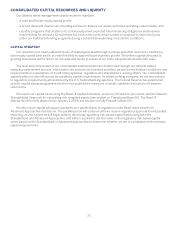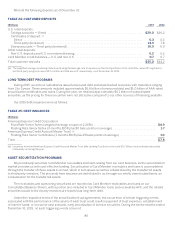American Express 2015 Annual Report Download - page 86
Download and view the complete annual report
Please find page 86 of the 2015 American Express annual report below. You can navigate through the pages in the report by either clicking on the pages listed below, or by using the keyword search tool below to find specific information within the annual report.
We seek to maintain capital levels and ratios in excess of the minimum regulatory requirements and finance such
capital in a cost efficient manner; failure to maintain minimum capital levels could affect our status as a financial
holding company and cause the respective regulatory agencies to take actions that could limit our business
operations.
Our primary source of equity capital has been the generation of net income. Historically, capital generated
through net income and other sources, such as the exercise of stock options by employees, has exceeded the annual
growth in our capital requirements. To the extent capital has exceeded business, regulatory and rating agency
requirements, we have historically returned excess capital to shareholders through our regular common share
dividend and share repurchase program.
We maintain certain flexibility to shift capital across our businesses as appropriate. For example, we may infuse
additional capital into subsidiaries to maintain capital at targeted levels in consideration of debt ratings and regulatory
requirements. These infused amounts can affect the capital profile and liquidity levels at the American Express parent
company level. We do not currently intend or foresee a need to shift capital from non-U.S. subsidiaries with
permanently reinvested earnings to a U.S. parent company.
The following are definitions for our regulatory risk-based capital ratios and leverage ratio, which are calculated as
per standard regulatory guidance:
Risk-Weighted Assets — Assets are weighted for risk according to a formula used by the Federal Reserve to
conform to capital adequacy guidelines. On- and off-balance sheet items are weighted for risk, with off-balance sheet
items converted to balance sheet equivalents, using risk conversion factors, before being allocated a risk-adjusted
weight. The off-balance sheet items comprise a minimal part of the overall calculation. Risk-weighted assets under
Basel III as of December 31, 2015 were $135.2 billion.
Common Equity Tier 1 Risk-Based Capital Ratio — The Common Equity Tier 1 risk-based capital ratio is calculated
as Common Equity Tier 1 capital, divided by risk-weighted assets. Common Equity Tier 1 is the sum of common
shareholders’ equity, adjusted for ineligible goodwill and intangible assets, certain deferred tax assets, as well as
certain other comprehensive income items as follows: net unrealized gains/losses on securities and derivatives, and
net unrealized pension and other postretirement benefit losses, all net of tax and subject to transition provisions.
Common Equity Tier 1 capital as of December 31, 2015 was $16.7 billion.
Tier 1 Risk-Based Capital Ratio — The Tier 1 capital ratio is calculated as Tier 1 capital divided by risk-weighted
assets. Tier 1 capital is the sum of Common Equity Tier 1 capital, our perpetual preferred stock and third-party non-
controlling interests in consolidated subsidiaries adjusted for capital to be held by insurance subsidiaries and deferred
tax assets from net operating losses not deducted from Common Equity Tier 1 capital. Tier 1 capital as of December 31,
2015 was $18.3 billion.
Total Risk-Based Capital Ratio — The total risk-based capital ratio is calculated as the sum of Tier 1 capital and Tier
2 capital, divided by risk-weighted assets. Tier 2 capital is the sum of the allowance for receivable and loan losses
(limited to 1.25 percent of risk-weighted assets) a portion of the unrealized gains on equity securities, $600 million of
subordinated notes issued in the fourth quarter of 2014 and $750 million of subordinated debentures adjusted for
capital to be held by insurance subsidiaries. The $750 million of subordinated debentures do not meet the
requirements of Tier 2 capital under Basel III, and are being transitioned out of capital (the total amount included in
Tier 2 capital as of December 31, 2015 was $187 million). Hence, the total amount of subordinated debt included in Tier
2 capital as of December 31, 2015 was $787 million. Tier 2 capital as of December 31, 2015 was $2.3 billion. The $750
million of subordinated debentures have been fully transitioned out of capital as of January 1, 2016. See “Fully Phased-
in Basel III” section.
Tier 1 Leverage Ratio — The Tier 1 leverage ratio is calculated by dividing Tier 1 capital by our average total
consolidated assets for the most recent quarter. Average total consolidated assets as of December 31, 2015 were
$156.4 billion.
The following is a definition for Tangible Common Equity to Risk-Weighted Assets ratio, which is widely used in the
marketplace, although it may be calculated differently by different companies:
Common Equity and Tangible Common Equity to Risk-Weighted Assets Ratios — Common equity equals our
shareholders’ equity of $20.7 billion as of December 31, 2015, less preferred shares of $1.6 billion. Tangible common
equity, a non-GAAP measure, equals common equity less goodwill and other intangibles of $3.5 billion as of
December 31, 2015. We believe presenting the ratio of tangible common equity to risk-weighted assets is a useful
measure of evaluating the strength of our capital position.
75
























